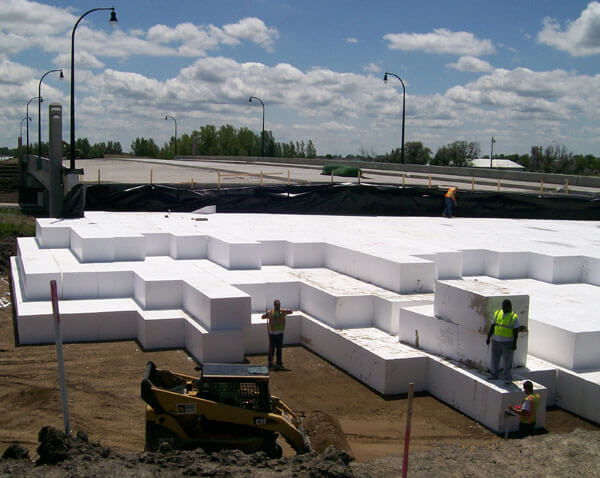Expanded Polystyrene (EPS): Most common foam products like architectural shapes, large foam blocks, coolers, wine shippers, Geofoam, roofing insulation, molded end caps and corners, box packaging and even cups at the office water cooler are actually polystyrene foam. Expanded Polystyrene (EPS) is the generic industry name for the white rigid material made by expanding polystyrene beads with steam and pressure to bond the beads together to form blocks or to shape molds. EPS is also used in the construction industry for insulation and void fill. Geofoam typically refers to EPS that is molded in blocks and used as lightweight fill in building and road construction.
STYROFOAM™ Brand Foam for Construction: STYROFOAM is a registered trademark of the Dow Chemical Company (Dow) or an affiliated company of Dow. This trademark covers a full range of extruded polystyrene building products used primarily in construction for wall insulation, floor insulation, and roof insulation systems. These insulation panels are commonly referred to as blue board in the construction industry. Most often the word Styrofoam is generically used to describe expanded polystyrene foam products like disposable coffee cups, cooler and other foam packaging materials, none of which are actually STYROFOAM.
No special equipment is required when building with EPS geofoam. Blocks can often be carried and set in place by laborers or easily handled with mechanized equipment. This is an important consideration when the construction site is congested or does not have the clearances required for traditional placement or compaction equipment. EPS geofoam can be field cut using a hot-wire cutter, hand saw, or chain saw. The EPS geofoam can be trimmed on site to accommodate the shapes of existing underground utilities and services.
EPS geofoam can be reground, recycled and reused in many composite applications such as lightweight concrete, plastic lumber, weather resistant outdoor decks, fencing, drain field aggregate, etc. Compared with traditional fill materials, fewer trucks with lighter loads are required to deliver EPS geofoam to a project site. This means less pollution from fuel emissions and less wear and tear on the nation’s roadways and infrastructure.
EPS geofoam is available in a range of compressive resistances. A project designer can choose the specific type of EPS required to support the design loading while minimizing cost. Several different types of EPS geofoam can be specified on a single project to maximize savings. For example, higher strength EPS geofoam can be used in high applied stress areas while lower strength blocks are used in areas where the applied stresses are lower.
EPS Geofoam design loads are recommended to not exceed the compressive resistance at 1% capacity. This limit controls the amount of long-term deflection, or creep, resulting from permanent sustained loads. Note: Adequate soil cover, or a load distribution slab, may be needed to distribute heavy concentrated loads.
With over 100 manufacturing locations within the United States, you can rest assured that our products will be shipped just in time to your project job site.
Construction time
EPS geofoam helps projects maintain extremely tight construction schedules. The ease and speed with which EPS geofoam can be constructed results in shorter construction time because of faster placement rates, reduced utility relocation and less disruption of traffic in urban areas. Additionally, adverse weather conditions typically do not affect placement rates of EPS geofoam.
Construction cost
In addition to other project costs, using EPS geofoam reduces the loading on adjacent supporting structures. Adjacent structures can be designed to be less robust and therefore less expensive. This is particularly important for underground utilities. Typically the higher cost of some types of lightweight fill materials is usually offset by savings when all of the project costs are considered, such as lower installation costs and lower maintenance. Available in a range of compressive resistances, EPS geofoam allows for economical project design.

